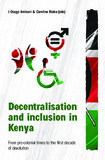| dc.contributor.author | Thuo, Lucianna | |
| dc.contributor.author | Kioko, Caroline | |
| dc.date.accessioned | 2023-02-16T12:38:40Z | |
| dc.date.available | 2023-02-16T12:38:40Z | |
| dc.date.issued | 2023 | |
| dc.identifier.uri | http://ir.kabarak.ac.ke/handle/123456789/1412 | |
| dc.description.abstract | The African Peer Review Mechanism Country Review Mission
(CRM) observed as follows in relation to marginalisation in Kenya:
There exists in Kenya an asymmetric exclusion of different social groups, i.e.,
various groups have been excluded for different reasons and face different
structural problems. It is not appropriate to paint with very broad-brush
strokes when designing appropriate intervention or advocacy measures
for affected populations. The major problem for disadvantaged groups
seems to be the inadequacy of government resources required to bolster
service delivery efforts. The inequitable allocation of resources to certain
areas and sectors of society has also spawned systemic marginalisation
and discrimination, which affects vulnerable groups disproportionately.
Affirmative action is more appropriate for those groups that require the
removal of structural barriers and the strengthening of policy tools and
development inputs for those whose problems stem from inaccessibility of
resources and infrastructure. | en_US |
| dc.language.iso | en | en_US |
| dc.publisher | Kabarak University | en_US |
| dc.subject | Marginalisation | en_US |
| dc.subject | Kenya | en_US |
| dc.subject | promise | en_US |
| dc.title | Marginalisation in Kenya in historical perspective (1963-2021): The starts, false starts and the last promise | en_US |
| dc.title.alternative | Decentralisation and inclusion in Kenya | en_US |
| dc.type | Book chapter | en_US |

